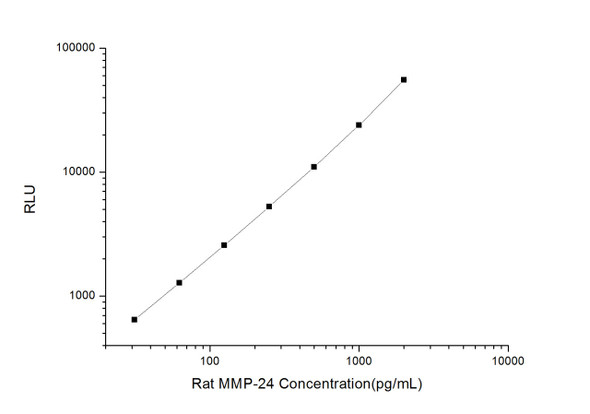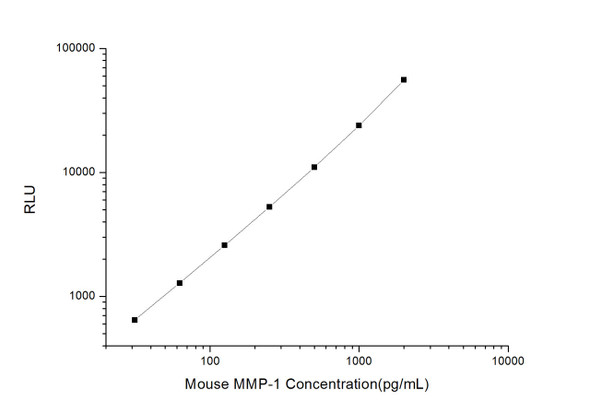Mouse Cell Biology ELISA Kits 2
Mouse MMP-24 (Matrix Metalloproteinase 24) CLIA Kit (MOES00436)
- SKU:
- MOES00436
- Product Type:
- ELISA Kit
- ELISA Type:
- CLIA Kit
- Size:
- 96 Assays
- Sensitivity:
- 18.75pg/mL
- Range:
- 31.25-2000pg/mL
- ELISA Type:
- Sandwich
- Synonyms:
- MMP24, MT-MMP5, MT5-MMP, MT5MMP, MTMMP5
- Reactivity:
- Mouse
- Sample Type:
- Serum, plasma and other biological fluids
- Research Area:
- Cell Biology
Description
| Assay type: | Sandwich |
| Format: | 96T |
| Assay time: | 4.5h |
| Reactivity: | Mouse |
| Detection method: | Chemiluminescence |
| Detection range: | 31.25-2000 pg/mL |
| Sensitivity: | 18.75 pg/mL |
| Sample volume: | 100µL |
| Sample type: | Serum, plasma and other biological fluids |
| Repeatability: | CV < 15% |
| Specificity: | This kit recognizes Mouse MMP-24 in samples. No significant cross-reactivity or interference between Mouse MMP-24 and analogues was observed. |
This kit uses Sandwich-CLIA as the method. The micro CLIA plate provided in this kit has been pre-coated with an antibody specific to Mouse MMP-24. Standards or samples are added to the appropriate micro CLIA plate wells and combined with the specific antibody. Then a biotinylated detection antibody specific for Mouse MMP-24 and Avidin-Horseradish Peroxidase (HRP) conjugate are added to each micro plate well successively and incubated. Free components are washed away. The substrate solution is added to each well. Only those wells that contain Mouse MMP-24, biotinylated detection antibody and Avidin-HRP conjugate will appear fluorescence. The Relative light unit (RLU) value is measured spectrophotometrically by the Chemiluminescence immunoassay analyzer. The RLU value is positively associated with the concentration of Mouse MMP-24. The concentration of Mouse MMP-24 in the samples can be calculated by comparing the RLU of the samples to the standard curve.
| UniProt Protein Function: | Metalloprotease that mediates cleavage of N-cadherin (CDH2) and acts as a regulator of neuro-immune interactions and neural stem cell quiescence (PubMed:19805319, PubMed:24952463). Involved in cell-cell interactions between nociceptive neurites and mast cells, possibly by mediating cleavage of CDH2, thereby acting as a mediator of peripheral thermal nociception and inflammatory hyperalgesia (PubMed:19805319). Key regulator of neural stem cells quiescence by mediating cleavage of CDH2, affecting CDH2-mediated anchorage of neural stem cells to ependymocytes in the adult subependymal zone, leading to modulate their quiescence (PubMed:24952463). May play a role in axonal growth (PubMed:11714638). Able to activate progelatinase A. May also be a proteoglycanase involved in degradation of proteoglycans, such as dermatan sulfate and chondroitin sulfate proteoglycans. Cleaves partially fibronectin, but not collagen type I, nor laminin (PubMed:10622708). |
| NCBI Summary: | This gene encodes a member of the matrix metalloproteinase family of extracellular matrix-degrading enzymes that are involved in tissue remodeling, wound repair, progression of atherosclerosis and tumor invasion. The encoded preproprotein undergoes proteolytic processing to generate a mature, zinc-dependent endopeptidase enzyme. Mice lacking the encoded protein do not develop neuropathic pain with mechanical allodynia after sciatic nerve injury, display enhanced sensitivity to noxious thermal stimuli under basal conditions, and develop hyperalgesia during inflammation. [provided by RefSeq, Feb 2016] |
| UniProt Code: | Q9R0S2 |
| NCBI GenInfo Identifier: | 115495469 |
| NCBI Gene ID: | 17391 |
| NCBI Accession: | NP_034938. 3 |
| UniProt Secondary Accession: | Q9R0S2,Q9Z0J9, A2AUV7, |
| UniProt Related Accession: | Q9R0S2 |
| Molecular Weight: | 66. 4 kDa |
| NCBI Full Name: | matrix metalloproteinase-24 preproprotein |
| NCBI Synonym Full Names: | matrix metallopeptidase 24 |
| NCBI Official Symbol: | Mmp24 |
| NCBI Official Synonym Symbols: | MMP-21; MT5MMP; MTMMP5; MT5-MMP; AU040325 |
| NCBI Protein Information: | matrix metalloproteinase-24 |
| UniProt Protein Name: | Matrix metalloproteinase-24 |
| UniProt Synonym Protein Names: | Matrix metalloproteinase-21; MMP-21 |
| Protein Family: | Matrix metalloproteinase |
| UniProt Gene Name: | Mmp24 |
As the RLU values of the standard curve may vary according to the conditions of the actual assay performance (e. g. operator, pipetting technique, washing technique or temperature effects), the operator should establish a standard curve for each test. Typical standard curve and data is provided below for reference only.
| Concentration (pg/mL) | RLU | Average | Corrected |
| 2000 | 50936 60506 | 55721 | 55693 |
| 1000 | 22691 25257 | 23974 | 23946 |
| 500 | 11627 10437 | 11032 | 11004 |
| 250 | 4842 5746 | 5294 | 5266 |
| 125 | 2644 2572 | 2608 | 2580 |
| 62.5 | 1389 1233 | 1311 | 1283 |
| 31.25 | 673 675 | 674 | 646 |
| 0 | 27 29 | 28 | -- |
Precision
Intra-assay Precision (Precision within an assay): 3 samples with low, mid range and high level Mouse MMP-24 were tested 20 times on one plate, respectively.
Inter-assay Precision (Precision between assays): 3 samples with low, mid range and high level Mouse MMP-24 were tested on 3 different plates, 20 replicates in each plate.
| Intra-assay Precision | Inter-assay Precision | |||||
| Sample | 1 | 2 | 3 | 1 | 2 | 3 |
| n | 20 | 20 | 20 | 20 | 20 | 20 |
| Mean (pg/mL) | 94.81 | 254.73 | 717.95 | 88.42 | 258.29 | 782.09 |
| Standard deviation | 8.18 | 27.84 | 45.30 | 7.18 | 25.21 | 55.84 |
| C V (%) | 8.63 | 10.93 | 6.31 | 8.12 | 9.76 | 7.14 |
Recovery
The recovery of Mouse MMP-24 spiked at three different levels in samples throughout the range of the assay was evaluated in various matrices.
| Sample Type | Range (%) | Average Recovery (%) |
| Serum (n=5) | 94-106 | 100 |
| EDTA plasma (n=5) | 98-112 | 105 |
| Cell culture media (n=5) | 90-104 | 97 |
Linearity
Samples were spiked with high concentrations of Mouse MMP-24 and diluted with Reference Standard & Sample Diluent to produce samples with values within the range of the assay.
| Serum (n=5) | EDTA plasma (n=5) | Cell culture media (n=5) | ||
| 1:2 | Range (%) | 100-114 | 100-115 | 89-102 |
| Average (%) | 106 | 107 | 95 | |
| 1:4 | Range (%) | 89-103 | 88-102 | 97-115 |
| Average (%) | 96 | 94 | 105 | |
| 1:8 | Range (%) | 103-117 | 101-116 | 94-107 |
| Average (%) | 109 | 107 | 101 | |
| 1:16 | Range (%) | 91-103 | 90-107 | 102-116 |
| Average (%) | 97 | 98 | 109 |
An unopened kit can be stored at 4°C for 1 month. If the kit is not used within 1 month, store the items separately according to the following conditions once the kit is received.
| Item | Specifications | Storage |
| Micro CLIA Plate(Dismountable) | 8 wells ×12 strips | -20°C, 6 months |
| Reference Standard | 2 vials | |
| Concentrated Biotinylated Detection Ab (100×) | 1 vial, 120 µL | |
| Concentrated HRP Conjugate (100×) | 1 vial, 120 µL | -20°C(shading light), 6 months |
| Reference Standard & Sample Diluent | 1 vial, 20 mL | 4°C, 6 months |
| Biotinylated Detection Ab Diluent | 1 vial, 14 mL | |
| HRP Conjugate Diluent | 1 vial, 14 mL | |
| Concentrated Wash Buffer (25×) | 1 vial, 30 mL | |
| Substrate Reagent A | 1 vial, 5 mL | 4°C (shading light) |
| Substrate Reagent B | 1 vial, 5 mL | 4°C (shading light) |
| Plate Sealer | 5 pieces | |
| Product Description | 1 copy | |
| Certificate of Analysis | 1 copy |
- Set standard, test sample and control (zero) wells on the pre-coated plate and record theirpositions. It is recommended to measure each standard and sample in duplicate. Note: addall solutions to the bottom of the plate wells while avoiding contact with the well walls. Ensuresolutions do not foam when adding to the wells.
- Aliquot 100µl of standard solutions into the standard wells.
- Add 100µl of Sample / Standard dilution buffer into the control (zero) well.
- Add 100µl of properly diluted sample (serum, plasma, tissue homogenates and otherbiological fluids. ) into test sample wells.
- Cover the plate with the sealer provided in the kit and incubate for 90 min at 37°C.
- Aspirate the liquid from each well, do not wash. Immediately add 100µL of BiotinylatedDetection Ab working solution to each well. Cover the plate with a plate seal and gently mix. Incubate for 1 hour at 37°C.
- Aspirate or decant the solution from the plate and add 350µL of wash buffer to each welland incubate for 1-2 minutes at room temperature. Aspirate the solution from each well andclap the plate on absorbent filter paper to dry. Repeat this process 3 times. Note: a microplatewasher can be used in this step and other wash steps.
- Add 100µL of HRP Conjugate working solution to each well. Cover with a plate seal andincubate for 30 min at 37°C.
- Aspirate or decant the solution from each well. Repeat the wash process for five times asconducted in step 7.
- Add 100µL of Substrate mixture solution to each well. Cover with a new plate seal andincubate for no more than 5 min at 37°C. Protect the plate from light.
- Determine the RLU value of each well immediately.






